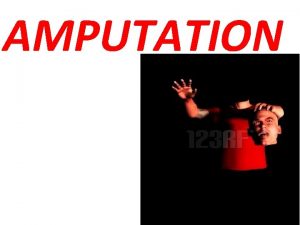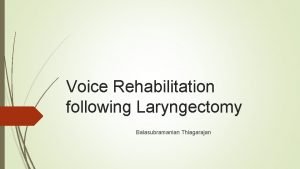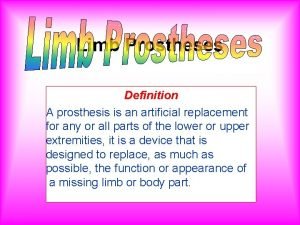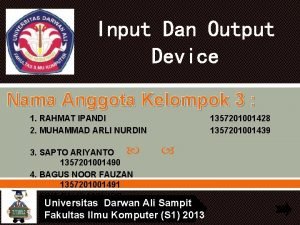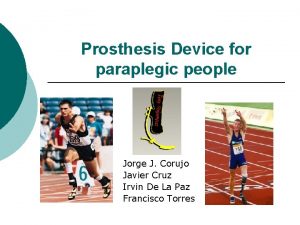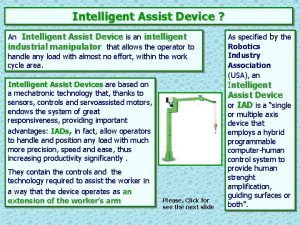Prosthesis A prosthesis is a device that is






















- Slides: 22


Prosthesis • A prosthesis is a device that is designed to replace, as much as possible, the function or appearance of a missing limb or body part. • It is a device that is designed to support, supplement, or augment the function of an existing limb or body part.

Most common reasons for an upper extremity amputation • Correction of a congenital deformity or • Tumor is commonly seen in individuals aged 0 -15 years. • Trauma is the most common reason for amputation in patients aged 15 -45 years, with tumors being a distant second. • Upper extremity amputations tend to be rare in patients who are older than 60 years, but they may be required secondary to tumor or medical disease.

Amputation levels • • • Transphalangeal amputation Transmetacarpal amputation Transcarpal amputation Wrist disarticulation Transradial amputation Elbow disarticulation Transhumeral amputation Shoulder disarticulation Interscapulothoracic disarticulation

DIFFERENT TYPES OF PROSTHESES • The continuum of prostheses ranges from mostly passive or cosmetic types on one end to primarily functional types on the other. The purpose of most prostheses falls somewhere in the middle. Cosmetic prostheses can look extremely natural, but they often are more difficult to keep clean, can be expensive, and usually sacrifice some function for increased cosmetic appearance.

Functional prostheses generally can be divided into the following 2 categories • Body-powered prostheses - Cable controlled • Externally powered prostheses - Electrically powered. – Myo-electric prostheses – Switch-controlled prostheses

Body-powered prostheses • Body-powered prostheses (cables) usually are of moderate cost and weight. They are the most durable prostheses and have higher sensory feedback. However, a body-powered prosthesis is more often less cosmetically pleasing than a myoelectrically controlled type is, and it requires more gross limb movement.

Externally powered prostheses • Prostheses powered by electric motors may provide more proximal function and greater grip strength, along with improved cosmesis, but they can be heavy and expensive. Patient-controlled batteries and motors are used to operate these prostheses. Currently available designs generally have less sensory feedback and require more maintenance than do body-powered prostheses. Externally powered prostheses require a control system. The two types of commonly available control systems are myoelectric and switch control

TYPICAL COMPONENTS OF AN UPPER EXTREMITY, BODY-POWERED PROSTHESIS • A typical example of a transradial (below-elbow) prosthesis includes a voluntary opening split hook; a friction wrist; a double-walled, plastic-laminate socket; a flexible elbow hinge; a single–controlcable system; a triceps cuff; and a figure-8 harness. • A transhumeral (above-elbow) prosthesis is similar but includes an internal-locking elbow with a turntable for the missing anatomic elbow, uses a dual–control-cable system instead of a single-control cable, and does not require a triceps cuff. • All conventional body-powered, upper extremity prostheses have the following components:

. All conventional body-powered, upper extremity prostheses have the following components • • • Socket Suspension Control-cable system Terminal device Components for any interposing joints as needed according to the level of amputation

Socket • The socket of an upper extremity prosthesis typically has a dual-wall design fabricated from lightweight plastic or graphite composite materials. In this design, a rigid inner socket is fabricated to fit the patient's residual limb and the second, outer wall is added, designed to be the same length and contour as the opposite, sound limb. Comfort and function are directly tied to the fit of the inner socket. An alternative approach parallels the rigid frame, flexible liner approach sometimes used in lower extremity socket fabrication. The inner socket is fabricated from flexible plastic materials to provide appropriate contact and fit. Surrounding the flexible liner, a rigid frame is utilized for structural support and for attaching the necessary cables and joints as needed. The windows in the outer socket allow movement, permit relief over bony prominences, and enhance comfort.

Suspension • The suspension system must hold the prosthesis securely to the residual limb, as well as accommodate and distribute the forces associated with the weight of the prosthesis and any superimposed lifting loads. Suspension systems can be classified as follows: • Harnessed-based systems. • Self-suspending sockets. • Suction sockets.

Harnessed-based systems • Harnessed-based systems and their variants are the most commonly used systems. For the figure-8 strap, a harness loops around the axilla on the sound side. This anchors the harness and provides the counterforce for suspension and control-cable forces. On the prosthetic side, the anterior (superior) strap carries the major suspending forces to the prosthesis by attaching directly to the socket in a transhumeral prosthesis or indirectly to a transradial socket through an intermediate Y-strap and triceps cuff. The posterior (inferior) strap on the prosthetic side attaches to the control cable. For heavier lifting or as an alternative to the figure-8 harness, a shoulder saddle with a chest-strap suspension can be used with a transradial prosthesis. A chest strap alone is sometimes used to suspend a transhumeral prosthesis. The figure-9 harness is an alternative for a patient with a long transradial amputation or a wrist disarticulation, in order to provide the control harness provides minimal suspension and requires a self -suspending socket, it is more comfortable than a figure-8 harness. Selfsuspending and suction sockets are capable of providing adequate prosthetic suspension without the use of a harness. However, either design can also be used with a harness suspension to provide for a more secure suspension of the prosthesis.

Self-suspending sockets • Self-suspending sockets are largely limited to wrist or elbow disarticulations and to transradial amputations. This socket design is most commonly utilized with an externally powered, myoelectrically controlled transradial prosthesis. An example of this type is the Munster socket. Proper fit of this socket precludes full elbow extension.

Suction suspension • Suction suspension is similar to lower extremity options. These sockets use an external, elastic suspension sleeve; a one-way air valve; or roll-on gel suspension liner with a pin-locking mechanism. Upper limb suction sockets (unlike nonsuction sockets) require a total contact socket design and ideally a residual limb with no skin invagination, scarring, and stable volume to avoid skin problems, such as a choke syndrome. Suction socket designs are most commonly used for the patient with a transhumeral amputation.

Control-cable mechanisms • Control-cable mechanisms • Body-powered prosthetic limbs use cables to link movements of 1 part of the body to the prosthesis in order to control a prosthetic function. This usually is a movement of the humerus, shoulder, or chest, which is transferred via a Bowden cable (a single cable passing through a single housing) to activate the terminal device of the prosthesis. A control cable used to activate a single prosthetic component or function is called a single-control cable, or Bowden cable system. A dual–control-cable system uses the same cable to control 2 prosthetic functions (such as flexion of the elbow and, when the elbow is locked, activation of the terminal device). This latter control cable setup is accomplished with a single cable passing through two separate cable.

Body movements that are captured for prosthetic control • • Glenohumeral forward flexion • Biscapular abduction (chest expansion. • Glenohumeral depression/elevation, extension, abduction -

TERMINAL DEVICE • The major function of the hand that a prosthesis tries to replicate is grip (prehension). • The 5 different types of grips are as follows

• • • Precision grip Tripod grip Lateral grip Hook power grip Spherical grip

Terminal devices generally are broken down into 2 categories: passive and active. • • Passive terminal devices fall into two classes, those designed primarily for function and those to provide cosmesis. Examples of the functional passive terminal devices include the child mitt frequently used on an infant's first prosthesis to facilitate crawling or the ball handling terminal devices used by older children and adults for ball sports. The main advantage of most passive terminal devices is their cosmetic appearance. With newer advances in materials and design, some passive hands are virtually indistinguishable from the native hand. However, most of these cosmetic passive terminal devices usually are less functional and more expensive than active terminal devices. Active terminal devices usually are more functional than cosmetic; however, in the near future, active devices that are equally cosmetic and functional may be available. Active devices can be broken down into 2 main categories: hook (and similarly specialized function) terminal devices and prosthetic hands. There are designs of both of these terminal device groups available to operate with cable or externally powered prostheses.

WRIST, ELBOW, SHOULDER, AND FOREQUARTER UNITS

 Internal input devices
Internal input devices Sau thất bại ở hồ điển triệt
Sau thất bại ở hồ điển triệt Thơ thất ngôn tứ tuyệt đường luật
Thơ thất ngôn tứ tuyệt đường luật Con hãy đưa tay khi thấy người vấp ngã
Con hãy đưa tay khi thấy người vấp ngã Thơ thất ngôn tứ tuyệt đường luật
Thơ thất ngôn tứ tuyệt đường luật Tôn thất thuyết là ai
Tôn thất thuyết là ai Phân độ lown
Phân độ lown Walmart thất bại ở nhật
Walmart thất bại ở nhật Gây tê cơ vuông thắt lưng
Gây tê cơ vuông thắt lưng Block nhĩ thất độ 2 mobitz 2
Block nhĩ thất độ 2 mobitz 2 Tìm độ lớn thật của tam giác abc
Tìm độ lớn thật của tam giác abc Rpd indications
Rpd indications Syme amputation
Syme amputation Partial varia breast shapers
Partial varia breast shapers Tokyo artificial larynx
Tokyo artificial larynx Purpose of prosthesis
Purpose of prosthesis Maxillofacial prosthesis classification
Maxillofacial prosthesis classification Befrest
Befrest Trinity amputation and prosthesis experience scales
Trinity amputation and prosthesis experience scales Transphalangeal amputation definition
Transphalangeal amputation definition A tagout device is preferable to using a lockout device.
A tagout device is preferable to using a lockout device. Input device dan output device
Input device dan output device Ports in embedded system
Ports in embedded system












